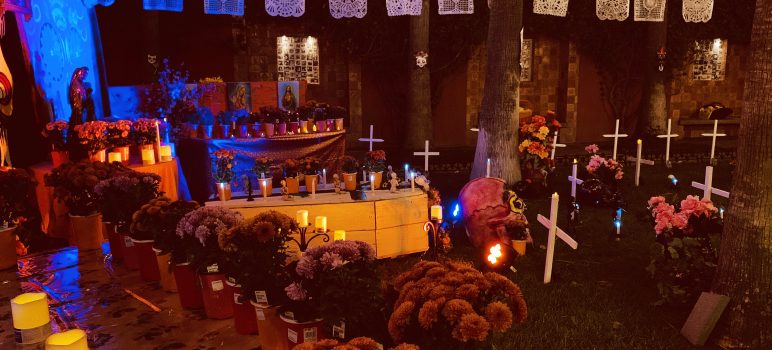We all know about Day of the Dead or Dawn of the Dead. But what about a Drive of the Dead?
Every year at this time, The School of Arts and Culture at Mexican Heritage Plaza helps organize a Dia de los Muertos (Day of the Dead) weekend to acknowledge the Latin American holiday during which the living commemorate their departed loved ones through the construction of elaborate altars.
The celebration includes the sharing of food, drinks, artworks and memories, as the plaza bustles with activity all weekend long. People laugh, cry, play music and tell stories. Aztec dancers, mariachis and other traditional ensembles perform. Hundreds of families show up to view every detail of the altars, up close and personal. It’s one of the most colorful weekends of the year, at least on the East Side.
This year, a more somber mood already envelops the landscape. Covid-19 has left a disproportionate impact on the residents of East San Jose, many who are essential workers now taking on risks that others have the privilege to avoid. And due to pandemic restrictions, the plaza can’t just throw a Sturgis rally and pack the place with thousands of people. As a result, this year the event will transform into a drive-through experience, Avenida de Altares, from 6 to 9pm Friday and Saturday.
“Our parking lot on the Alum Rock side of the plaza is basically being turned into multiple makeshift avenues and people get to snake around and drive through,” Edgar Ochoa, manager of the school’s community engagement program said. “It’s going to be a Day of the Dead art installation in a sense, an experience where families get to come by—anyone in attendance really—and drive through it. We’re going to have a makeshift graveyard where people can pay their respect as they drive through.”
The school has an opportunity to honor not only those who’ve died during the event, but also the contributions of essential workers, whose lives have been thrown into chaos during these trying times. It’s yet another heroic example of people adapting to the situation and refusing to throw in the towel.
Sixteen local artists will set up altars much larger than what’s often constructed, primarily because visitors now must drive through to view the displays, rather than walk up and interact with the artists. There will be multiple lanes for vehicles, plus goodie bags for kids and candy for families to take home.
During the day, the Mexican Heritage Plaza will serve as a community center where people can vote from 9am to 5pm, followed by the Avenida de Altares in the evening. That is, people can make their voices heard during the day and then come back to commemorate those who have passed—those who can no longer vote—without giving up the Dia de los Muertos experience.
“It’s an interesting balance of an event and a celebration,” Ochoa said, admitting the word “celebration” might sound strange due to the number of Covid-19 deaths. “It’s more of a commemoration while honoring some of the long-standing traditions that we’ve upheld for the day.”
Even better, it turns out the school can potentially accommodate more people via the drive-through version of Day of the Dead than if the event still unfolded inside the plaza.
Over a four-hour event each night, Ochoa estimates it will take six minutes for each car to drive through and view the whole thing. With a rotation allowing for 30 cars every six minutes, the total would be about 300 vehicles every hour. Multiplied by four hours, that would equal about 1,200 vehicles.
Assuming anywhere from 2–5 people might likely be in each car, the total number of visitors could surpass 4,000 each evening if the drive-through convoy runs nonstop. This is much more than would normally circulate through the plaza on foot. Usually the area maxes out around 1,000 people. Talk about putting a positive spin on things.
Best of all, the event is free of charge.
“All you got to do is pay for the gas for your car,” Ochoa said.

